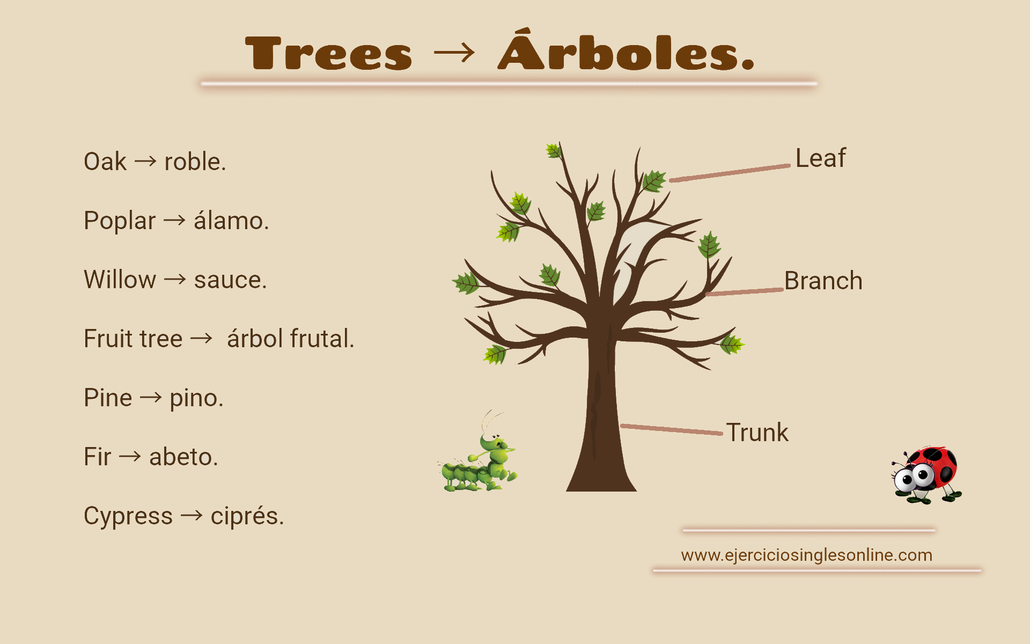Descripción: Árboles en inglés. En la siguiente entrada te presentamos el vocabulario relacionado con árboles en inglés. Puedes escuchar la pronunciación de las palabras.
Artículos relacionados:
Cuaderno de actividades relacionado con "árboles" (trees) en inglés.

- Acacia - əˈkeɪʃə - Acacia
- Acorn - ˈeɪkɔːn - Bellota
- Annual ring - ˈænjuəl rɪŋ - Anillo de crecimiento
- Ash - æʃ - Fresno
- Bamboo - bæmˈbuː - Bambú
- Bark - bɑːrk - Corteza
- Beech - biːtʃ - Haya
- Birch - bɜːrtʃ - Abedul
- Branch - bræntʃ - Rama
- Cedar - ˈsiːdər - Cedro
- Chestnut - ˈtʃestnʌt - Castaña
- Chestnut tree - ˈtʃestnʌt triː - Castaño
- Cone - kəʊn - Piña
- Conifers - ˈkɒnɪfəz - Coníferas
- Cypress - ˈsaɪprəs - Ciprés
- Fir - fɜːr - Abeto
- Fir needles - fɜːr ˈniːdəlz - Agujas de abeto
- Fruit tree - fruːt triː - Árbol frutal
- Hazel - ˈheɪzl - Avellano
- Holly - ˈhɒli - Acebo
- Horse chestnut - hɔːs ˈtʃestnʌt - Castaño de indias
- Lime tree - laɪm triː - Tilo
- Maple - ˈmeɪpl - Arce
- Mistletoe - ˈmɪsltoʊ - Muérdago
- Oak - oʊk - Roble
- Orchard - ˈɔːtʃərd - Huerto de frutales
- Poplar - ˈpɒplər - Álamo
- Redwood tree - ˈredwʊd triː - Secuoya
- Root - ruːt - Raíz
- Trunk - trʌŋk - Tronco
- Willow - ˈwɪloʊ - Sauce
EJEMPLOS
Oak - The oak tree produces acorns.
- El roble produce bellotas.
Acorn - The squirrel eats acorns from the oak tree.
- La ardilla come bellotas del árbol de roble.
Annual ring - Anillo de crecimiento: The annual rings on the tree trunk showed its age.
(Los anillos de crecimiento en el tronco del árbol mostraban su edad.)
Beech - The beech tree has smooth grey bark.
- El haya tiene una corteza gris suave.
Maple - Maple trees are known for their colorful leaves in the fall.
- Los árboles de arce son conocidos por sus hojas coloridas en el otoño.
Birch - The bark of the birch tree can be used to make paper.
- La corteza del abedul se puede usar para hacer papel.
Chestnut tree - The chestnut tree is a common sight in the countryside.
- El árbol de castaño es una vista común en el campo.
Horse chestnut - The horse chestnut tree produces large, shiny brown nuts.
- El castaño de indias produce grandes y brillantes nueces marrones.
Chestnut - We roasted chestnuts on the fire.
- Asamos castañas en el fuego.
Poplar - The poplar tree has leaves that flutter in the wind.
- El álamo tiene hojas que revolotean con el viento.
Willow - The branches of the willow tree can be used to make baskets.
- Las ramas del sauce se pueden usar para hacer cestas.
Lime tree - The lime tree produces small, green fruit that can be used to make tea.
- El tilo produce frutos pequeños y verdes que se pueden usar para hacer té.
Ash - The ash tree is known for its strong wood.
- El fresno es conocido por su madera resistente.
Mistletoe - Mistletoe is a parasitic plant that grows on trees.
- El muérdago es una planta parasitaria que crece en los árboles.
Fruit tree - The orchard has many different fruit trees.
- El huerto de frutales tiene muchos árboles frutales diferentes.
Orchard - The orchard is full of apples, pears, and plums.
- El huerto de frutales está lleno de manzanas, peras y ciruelas.
Bamboo - The panda eats bamboo as its primary source of food.
- El panda come bambú como su principal fuente de alimento.
Redwood tree - The redwood tree is one of the tallest trees in the world.
- El árbol de la secuoya es uno de los árboles más altos del mundo.
Acacia - The acacia tree has fragrant yellow flowers.
- La acacia tiene flores amarillas fragantes.
Holly - Holly trees have sharp, pointed leaves.
- Los acebos tienen hojas puntiagudas y afiladas.
Hazel - The hazel tree produces delicious nuts.
- El avellano produce deliciosas nueces.
Conifers - Conifers are trees that produce cones instead of flowers.
- Las coníferas son árboles que producen piñas en lugar de flores.
Pine - Pine trees have needles instead of leaves.
- Los pinos tienen agujas en lugar de hojas.
Fir - Fir trees are often used as Christmas trees.
- Los abetos a menudo se usan como árboles de Navidad.
Fir needles - The fir needles can be used to make tea.
- Las agujas de abeto se pueden usar para hacer té.
Cone - Piña: The pine cone fell from the tree and landed on the ground.
(La piña de pino cayó del árbol y aterrizó en el suelo.)
Cedar - Cedro: The aroma of the cedar tree filled the air.
(El aroma del árbol de cedro llenó el aire.)
Cypress - Ciprés: The tall cypress trees swayed in the wind.
(Los altos árboles de ciprés se mecían con el viento.)
Root - Raíz: The roots of the tree went deep into the ground.
(Las raíces del árbol se adentraban profundamente en la tierra.)
Trunk - Tronco: The thick trunk of the old oak tree had many branches.
(El grueso tronco del viejo roble tenía muchas ramas.)
Branch - Rama: The bird perched on a branch of the apple tree.
(El pájaro se posó en una rama del manzano.)
Leaf - Hoja: The green leaves of the beech tree rustled in the breeze.
(Las hojas verdes del árbol de haya crujieron con la brisa.)
Bark - Corteza: The bark of the birch tree was smooth and white.
(La corteza del abedul era suave y blanca.)
Bud - Yema: The buds on the fruit tree indicated that spring had arrived.
(Las yemas en el árbol frutal indicaban que la primavera había llegado.)
